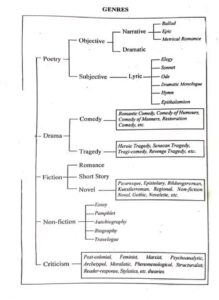
What is Genre?
*Genre*
*Definition of Genre*
“`Genre means a type of art, literature, or music characterized by a specific form, content, and style“` .
_For example_ ,
literature has four main genres:
*Poetry,*
*Drama*,
*Fiction, and*
*Non-fiction.*
“`All of these genres have particular features and functions that distinguish them from one another.“` Hence, it is necessary on the part of readers to know which category of genre they are reading in order to understand the message it conveys, as they may have certain expectations prior to the reading concerned.
*Types of Genre*
There are five types of genres in literature, which include:
*Poetry*
_Poetry is the first major literary genre_
. All types of poetry share specific characteristics. In fact, poetry is a form of text that follows a meter and rhythm, with each line and syllable. It is further subdivided into different genres, such an epic poem, narrative, romantic, dramatic, and lyric.
*Dramatic poetry* includes melodrama, tragedy, and comedy, while other poems includes ode, sonnet, elegy, ballad, song, and epic.
*Popular examples of epic poems include Paradise Lost, by John Milton,* The Iliad and The Odyssey, by Homer. Examples of romantic poems include Red Red Rose, by Robert Burns. All these poetic forms share specific features, such as they do not follow paragraphs or sentences; they use stanzas and lines instead. Some forms follow very strict rules of length, and number of stanzas and lines, such as villanelle, sonnet, and haiku. Others may be free-form, like Feelings, Now, by Katherine Foreman, which is devoid of any regular meter and rhyme scheme. Besides that, often poetry uses figurative language, such as metaphor, simile, onomatopoeia, hyperbole, and alliteration to create heightened effect.
*Drama*
Drama is a form of text that is performed in front of an audience. It is also called a play. Its written text contains dialogues, and stage directions. This genre has further categories such as comedy, tragedy, and tragicomedy. William Shakespeare is known as the father of English drama. His well-known plays include Taming of the Shrew, Romeo & Juliet, and Hamlet. Greek playwrights were the pioneers in this field, such as Sophocles’ masterpiece Oedipus Rex, and Antigone, while modern dramas include Death of a Salesman, by Arthur Miller.
*Prose*
This type of written text is different from poetry in that it has complete sentences organized into paragraphs. Unlike poetry, prose focuses on characters and plot, rather than focusing on sounds. It includes short stories and novels, while fiction and non-fiction are its sub genres. Prose is further categorized into essays, speeches, sermons, and interpretations.
*Fiction*
Fiction has three categories that are, realistic, non-realistic, and semi-fiction. Usually, fiction work is not real and therefore, authors can use complex figurative language to touch readers’ imaginations. Unlike poetry, it is more structured, follows proper grammatical pattern, and correct mechanics. A fictional work may incorporate fantastical and imaginary ideas from everyday life. It comprises some important elements such as plot, exposition, foreshadowing, rising action, climax, falling action, and resolution. Popular examples of literary fiction include, James Joyce’s novel A Portrait of an Artist as a Young Man, Charles Dickens’ A Tale of Two Cities, Jane Austen’s Pride and Prejudice, and Harper Lee’s To Kill a Mockingbird.
*Non-Fiction*
Non-fiction is a vast category that also has sub-genres; it could be creative like a personal essay, or factual, like a scientific paper. It may also use figurative language, however, not unlike poetry, or fiction has. Sometimes, non-fiction may tell a story, like an autobiography, or sometimes it may convey information to readers.
*Other examples of non-fiction include* biographies, diaries, memoirs, journals, fantasies, mysteries, and romances. A popular example of non-fiction genre is Michael Pollan’s highly celebrated book, The Omnivore’s Dilemma: A Natural History of Four Meals, which is an account of the eating habits of Americans.
*Function of Genre.*
Different genres have different roles. For example, fiction and dramatic genres help students and writers learn and improve their communication skills. A poetic genre, on the other hand, enhances imaginative and emotional power of the readers. Non-fictional texts and essays help readers develop analytical and persuasive capabilities. However, the major function of genre is to establish a code of behavior between the writers and audience, and keep the readers informed about the topics discussed or the themes presented.